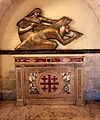Stations of the Cross

| Part of a series on |
| Devotions to Jesus in the Catholic Church |
|---|
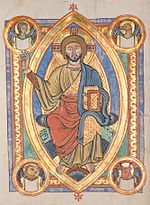 |
| Devotions |
|
| Prayers |
|
|
The Stations of the Cross or the Way of the Cross, also known as the Way of Sorrows or the Via Crucis, refers to a series of images depicting Jesus Christ on the day of his crucifixion and accompanying prayers. The stations grew out of imitations of Via Dolorosa in Jerusalem which is believed to be the actual path Jesus walked to Mount Calvary. The objective of the stations is to help the Christian faithful to make a spiritual pilgrimage through contemplation of the Passion of Christ. It has become one of the most popular devotions and the stations can be found in many Western Christian churches, including Anglican,[1] Lutheran,[2] Methodist,[3] and Roman Catholic.
Commonly, a series of 14 images will be arranged in numbered order along a path and the faithful travel from image to image, in order, stopping at each station to say the selected prayers and reflections. This will be done individually or in a procession most commonly during Lent, especially on Good Friday, in a spirit of reparation for the sufferings and insults that Jesus endured during his passion.[4][5]
The style, form, and placement of the stations vary widely. The typical stations are small plaques with reliefs or paintings placed around a church nave. Modern minimalist stations can be simple crosses with a numeral in the centre.[4][6] Occasionally the faithful might say the stations of the cross without there being any image, such as when the pope leads the stations of the cross around the Colosseum in Rome on Good Friday.[7]
History[]

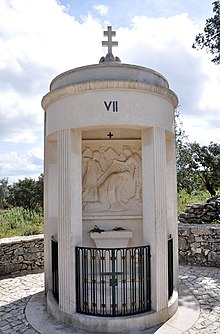
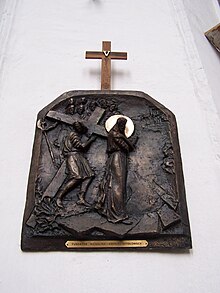
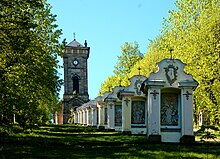

The Stations of the Cross originated in pilgrimage to Jerusalem and a desire to reproduce the Via Dolorosa. Imitating holy places was not a new concept. For example, the religious complex of Santo Stefano in Bologna, Italy, replicated the Church of the Holy Sepulchre and other religious sites, including Mount of Olives and Valley of Josaphat.[8]
After the siege of 1187, Jerusalem fell to the forces of Saladin, the first sultan of Egypt and Syria. Forty years later Franciscans were allowed back into the Holy Land. Their founder, Saint Francis of Assisi, held the Passion of Christ in special veneration and is said to have been the first person to receive stigmata.[9] In 1217, St. Francis also founded the Custody of the Holy Land to guard and promote the devotion to holy places. Their efforts were recognized when Franciscans were officially proclaimed custodians of holy places by Pope Clement VI in 1342.[9] Although several travelers who visited the Holy Land during the 12–14th centuries (e.g. Riccoldo da Monte di Croce, Burchard of Mount Sion, James of Verona), mention a "Via Sacra", i.e. a settled route that pilgrims followed, there is nothing in their accounts to identify this with the Way of the Cross, as we understand it.[10] The earliest use of the word "stations", as applied to the accustomed halting-places in the Via Sacra at Jerusalem, occurs in the narrative of an English pilgrim, William Wey, who visited the Holy Land in the mid-15th century, and described pilgrims following the footsteps of Christ to Golgotha. In 1521, a book called Geystlich Strass (German: "spiritual road") was printed with illustrations of the stations in the Holy Land.[10]
During the 15th and 16th centuries the Franciscans began to build a series of outdoor shrines in Europe to duplicate their counterparts in the Holy Land. The number of stations varied between seven and thirty; seven was common. These were usually placed, often in small buildings, along the approach to a church, as in a set of 1490 by Adam Kraft, leading to the Johanniskirche in Nuremberg.[11] A number of rural examples were established as attractions in their own right, usually on attractive wooded hills. These include the Sacro Monte di Domodossola (1657) and Sacro Monte di Belmonte (1712), and form part of the Sacri Monti of Piedmont and Lombardy World Heritage Site, together with other examples on different devotional themes. In these the sculptures are often approaching life-size and very elaborate. Remnants of these are often referred to as calvary hills.
In 1686, in answer to their petition, Pope Innocent XI granted to the Franciscans the right to erect stations within their churches. In 1731, Pope Clement XII extended to all churches the right to have the stations, provided that a Franciscan father erected them, with the consent of the local bishop. At the same time the number was fixed at fourteen. In 1857, the bishops of England were allowed to erect the stations by themselves, without the intervention of a Franciscan priest, and in 1862 this right was extended to bishops throughout the church.[12]
Stations[]
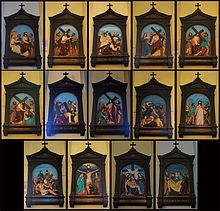

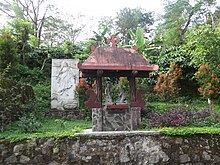
The early set of seven scenes was usually numbers 2, 3, 4, 6, 7, 11 and 14 from the list below.[11] The standard set from the late 16th to 20th centuries has consisted of 14 pictures or sculptures depicting the following scenes:[13][14][15]
- Jesus is condemned to death
- Jesus takes up his Cross
- Jesus falls for the first time
- Jesus meets his Mother
- Simon of Cyrene helps Jesus carry the Cross
- Veronica wipes the face of Jesus
- Jesus falls for the second time
- Jesus meets the women of Jerusalem
- Jesus falls for the third time
- Jesus is stripped of his garments (sometimes called the "Division of Robes")
- Jesus is nailed to the Cross
- Jesus dies on the Cross
- Jesus is taken down from the Cross
- Jesus is laid in the tomb
Although not traditionally part of the Stations, the Resurrection of Jesus is sometimes included as an unofficial fifteenth station.[dubious ][16] One very different version, called the Via Lucis ("Way of Light"), comprising the Fourteen Stations of Light or Stations of the Resurrection, starts Jesus rising from the dead and ends with Pentecost.[17]
Scriptural form[]
Out of the fourteen traditional Stations of the Cross, only eight have a clear scriptural foundation. Stations 3, 4, 6, 7, and 9 are not specifically attested to in the gospels; and Station 13 (Jesus's body being taken down off the cross and laid in the arms of his mother Mary) seems to embellish the gospels' record, which states that Joseph of Arimathea took Jesus down from the cross and buried him. To provide a version of this devotion more closely aligned with the biblical accounts, Pope John Paul II introduced a new form of devotion, called the Scriptural Way of the Cross, on Good Friday 1991. He celebrated that form many times but not exclusively at the Colosseum in Italy,[18][19] using the following sequence (as published by the United States Catholic Conference of Bishops):[20]
- Jesus is in the Garden of Gethsemane;
- Jesus is betrayed by Judas and arrested;
- Jesus is condemned by the Sanhedrin;
- Jesus is denied by Peter;
- Jesus is judged by Pilate;
- Jesus is scourged and crowned with thorns;
- Jesus takes up his cross;
- Jesus is helped by Simon of Cyrene to carry his cross;
- Jesus meets the women of Jerusalem;
- Jesus is crucified;
- Jesus promises his kingdom to the repentant thief;
- Jesus entrusts Mary and John to each other;
- Jesus dies on the cross; and
- Jesus is laid in the tomb.
In 2007, Pope Benedict XVI approved this set of stations for meditation and public celebration.[21][better source needed]
The New Way of the Cross (Philippines)[]
Another set of Stations are being used by the Catholic Church in the Philippines. Filipinos use this set during Visita Iglesia, which is usually done every Holy Week.
- The Last Supper
- The Agony in Gethsemane
- Jesus Before the Sanhedrin
- Jesus is scourged and crowned with thorns
- Jesus Receives His Cross
- Jesus Falls under the weight of the Cross
- Simon of Cyrene Helps Jesus carry the Cross
- Jesus meets the women of Jerusalem
- Jesus is nailed to the Cross
- The Repentant Thief
- Mary and John at the Foot of the Cross
- Jesus dies on the Cross
- Jesus is laid in His Tomb
- Jesus rises from the Dead
Modern usage[]

In the Roman Catholic Church, the devotion may be conducted personally by the faithful, making their way from one station to another and saying the prayers, or by having an officiating celebrant move from cross to cross while the faithful make the responses. The stations themselves must consist of, at the very least, fourteen wooden crosses—pictures alone do not suffice—and they must be blessed by someone with the authority to erect stations.[22]
Pope John Paul II led an annual public prayer of the Stations of the Cross at the Roman Colosseum on Good Friday. Originally, the pope himself carried the cross from station to station, but in his last years when age and infirmity limited his strength, John Paul presided over the celebration from a stage on the Palatine Hill, while others carried the cross. Just days prior to his death in 2005, Pope John Paul II observed the Stations of the Cross from his private chapel. Each year a different person is invited to write the meditation texts for the Stations. Past composers of the Papal Stations include several non-Catholics. The pope himself wrote the texts for the Great Jubilee in 2000 and used the traditional Stations.
The celebration of the Stations of the Cross is especially common on the Fridays of Lent, especially Good Friday. Community celebrations are usually accompanied by various songs and prayers. Particularly common as musical accompaniment is the Stabat Mater. At the end of each station the Adoramus Te is sometimes sung. The Alleluia is also sung, except during Lent.
Structurally, Mel Gibson's 2004 film, The Passion of the Christ, follows the Stations of the Cross.[23] The fifteenth and last station, the Resurrection, is not prominently depicted (compared to the other fourteen) but it is implied since the last shot before credit titles is Jesus resurrected and about to leave the tomb.
Debates[]
Place of Christ's resurrection[]
Some modern liturgists[24] say the traditional Stations of the Cross are incomplete without a final scene depicting the empty tomb and the resurrection of Jesus because Jesus' rising from the dead was an integral part of his salvific work on Earth. Advocates of the traditional form of the Stations ending with the body of Jesus being placed in the tomb say the Stations are intended as a meditation on the atoning death of Jesus, and not as a complete picture of his life, death, and resurrection. Another point of contention, at least between some ranking liturgists and traditionalists, is (the use of) the "New Way of the Cross" being recited exclusively in the Philippines and by Filipinos abroad.
The Stations of the Resurrection (also known by the Latin name of Via Lucis, Way of Light) are used in some churches at Eastertide to meditate on the Resurrection and Ascension of Jesus Christ.
Music[]
Franz Liszt wrote a Via Crucis for choir, soloists and piano or organ or harmonium in 1879. In 1931, French organist Marcel Dupré improvised and transcribed musical meditations based on fourteen poems by Paul Claudel, one for each station. Peter Maxwell Davies's Vesalii Icones (1969), for male dancer, solo cello and instrumental ensemble, brings together the Stations of the Cross and a series of drawings from the anatomical treatise De humani corporis fabrica (1543) by the Belgian physician Andreas van Wesel (Vesalius). In Davies's sequence, the final "station" represents the Resurrection, but of Antichrist, the composer's moral point being the need to distinguish what is false from what is real.[25] David Bowie regarded his 1976 song "Station to Station" as "very much concerned with the stations of the cross".[26] Paweł Łukaszewski wrote Via Crucis in 2000 and it was premiered by the Wrocław Opera on Good Friday March 30, 2018, and transmitted on TVP Kultura. Stefano Vagnini's 2002 modular oratorio, Via Crucis,[27] is a composition for organ, computer, choir, string orchestra and brass quartet.
As the Stations of the Cross are prayed during the season of Lent in Catholic churches, each station is traditionally followed by a verse of the Stabat Mater, composed in the 13th century by Franciscan Jacopone da Todi. James Matthew Wilson's poetic sequence, The Stations of the Cross, is written in the same meter as da Todi's poem.[28]
Literature[]
Dimitris Lyacos' third part of the Poena Damni trilogy, The First Death, is divided in fourteen sections in order to emphasise the "Via Dolorosa" of its marooned protagonist during his ascent on the mount of the island which constitutes the setting of the work.[citation needed][relevant?]
Gallery[]

1st Station: Jesus is condemned to death
2nd Station: Jesus takes up his Cross
3rd Station: Jesus falls for the first time
4th Station: Jesus meets his Mother
5th Station: Simon of Cyrene helps Jesus carry the Cross

6th Station: Veronica wipes the face of Jesus

7th Station: Jesus falls for the second time
8th Station: Jesus meets the women of Jerusalem
9th Station: Jesus falls for the third time

10th Station: Jesus is stripped of his garments (sometimes called the "Division of Robes")

11th Station: Jesus is nailed to the Cross

12th Station: Jesus dies on the cross

13th Station: Jesus is taken down from the Cross
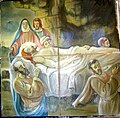
14th Station: Jesus is laid in the tomb
See also[]
- Acts of Reparation to Jesus Christ
- Life of Jesus in the New Testament
- Seven Sorrows of Mary
- Sayings of Jesus on the cross
- Three Hours' Agony
References[]
- ^ "Lent" (PDF). Church of England. 236. Retrieved 20 October 2017.
- ^ "Stations of the Cross". Holy Trinity Lutheran Church. Retrieved 20 October 2017.
- ^ "Stations of the Cross". Trinity UMC. 24 March 2013. Archived from the original on 17 April 2015. Retrieved 17 April 2015.
- ^ Jump up to: a b "Stations of the Cross". St. Michael's Episcopal Church. 2012. Archived from the original on 17 February 2015. Retrieved 3 March 2015.
- ^ Ann Ball, 2003 Encyclopedia of Catholic Devotions and Practices ISBN 0-87973-910-X
- ^ Chryssides, George D.; Wilkins, Margaret Z. (11 September 2014). Christians in the Twenty-First Century. Taylor & Francis. p. 51. ISBN 978-1-317-54557-6.
- ^ "Frommer's Events – Event Guide: Good Friday Procession in Rome (Palatine Hill, Italy)". Frommer's. Archived from the original on 7 January 2009. Retrieved 8 April 2008.
- ^ Ousterhout, Robert G. (1981). "The Church of Santo Stefano: A "Jerusalem" in Bologna". Gesta. 2 (20): 311–321. doi:10.2307/766940. ISSN 0016-920X. JSTOR 766940. S2CID 191752841.
- ^ Jump up to: a b Weitzel Gibbons, Mary (1995). Giambologna: Narrator of the Catholic Reformation. University of California Press. pp. 72–73. ISBN 978-0-520-08213-7.
- ^ Jump up to: a b Thurston, Herbert (1914). The Stations of the Cross: an account of their history and devotional purpose. London: Burns & Oates. pp. 20–21, 46. OCLC 843213.
- ^ Jump up to: a b Schiller, Gertrud, Iconography of Christian Art, Vol. II, p. 82, 1972 (English trans from German), Lund Humphries, London, ISBN 0-85331-324-5
- ^ The Catholic Encyclopedia (1907). s.v. "The Way of the Cross".
- ^ "Text of the Stations of the Cross for 2020, led by Pope Francis". Aleteia / Foundation for Evangelization through the Media (FEM). Retrieved 19 May 2020.
- ^ "First Station: Jesus is condemned to death". Libreria Editrice Vaticana. Retrieved 19 May 2020.
- ^ Francesca Merlo (10 April 2020). "Way of the Cross: Meditations from a corrections facility". Vatican News. Retrieved 19 May 2020.
- ^ "Fr. William Saunders". Archived from the original on 2009-04-30. Retrieved 2009-04-04.
Because of the intrinsic relationship between the passion and death of our Lord with His resurrection, several of the devotional booklets now include a 15th station, which commemorates the Resurrection.
- ^ "The Official Web Site for the Archdiocese of Detroit" (PDF). Archived from the original (PDF) on 2010-12-23. Retrieved 2012-02-13.
In some contemporary Stations of the Cross, a fifteenth station has been added to commemorate the Resurrection of the Lord.
- ^ Joseph M Champlin, The Stations of the Cross With Pope John Paul II Liguori Publications, 1994, ISBN 0-89243-679-4
- ^ Pope John Paul II, Meditation and Prayers for the Stations of the Cross at the Colosseum, Good Friday, 2000
- ^ "Scriptural Stations of the Cross". www.usccb.org. Retrieved 2019-03-11.
- ^ Office for the Liturgical Celebrations of the Supreme Pontiff (April 6, 2007). "Way of the Cross at the Colosseum". Vatican.va. Archived from the original on July 7, 2013. Retrieved February 18, 2018.
- ^ "Catholic Encyclopedia: Way of the Cross". Newadvent.org. 1912-10-01. Retrieved 2014-07-03.
- ^ Review Archived 2012-04-30 at the Wayback Machine, United States Conference of Catholic Bishops, 2004
- ^ McBrien, Richard P.; Harold W. Attridge (1995). The HarperCollins encyclopedia of Catholicism. p. 1222. ISBN 978-0-06-065338-5.
- ^ Composer's note in the published score (Boosey and Hawkes, B & H 20286).
- ^ Cavanagh, David (February 1997). "ChangesFiftyBowie". Q magazine: 52–59.
- ^ Falcon Valley Music Ed., Stefano Vagnini, Via Crucis, Rome, 2002.[not specific enough to verify]
- ^ "The Stations of the Cross : Clarion Review". www.clarionreview.org. Retrieved 2017-12-16.
External links[]
| Wikimedia Commons has media related to Stations of the Cross. |
- "Way of the Cross" article from The Catholic Encyclopedia
- The Way Of The Cross: Presentation (historical development; present form, both traditional and scriptural), from the official Vatican website (accessed 19 May 2020)
- Via Crucis celebration texts used by the Vatican on Good Fridays since 1991 from the official Vatican website
- Scriptural Stations of the Cross from the United States Conference of Catholic Bishops
- Video: Corine Schleif. Adam Kraft's Seven Falls of Christ. Walking the History of Emotions in Nuremberg. Part 1
- Video: Corine Schleif. Adam Kraft's Seven Falls of Christ. Walking the History of Emotions in Nuremberg. Part 2
- Stations of the Cross
- Christian iconography
- Christian terminology
- Cross symbols
- Passion of Jesus in art by theme
- Franciscan spirituality
- Catholic art by subject
- Catholic devotions
- Sorrowful Mysteries




